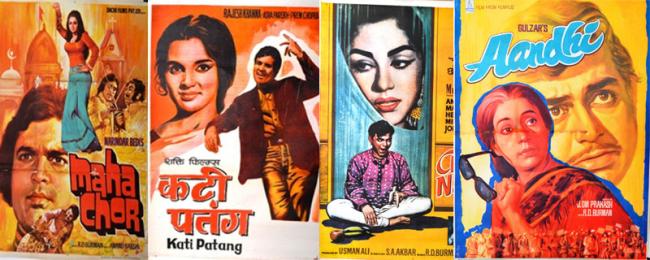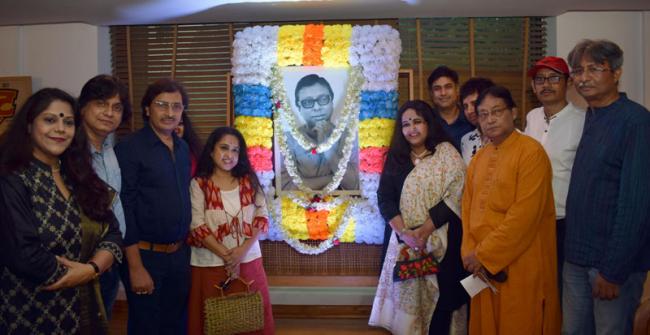
Remembering the poster boy of Bollywood tunes
Posters of films are milestones of nostalgia of times bygone. They constitute a history of cinema, of a typical kind of art that has stood the test of time for archivists like Sudipta Chanda who has amassed a collection of 1000 film posters. Shoma A. Chatterji takes us through a brief look-through of a Kolkata show dedicated by Chandra to late musical genius R.D. Burman on his 80thbirthday anniversary
Sudipta Chanda has amassed an amazing collection of around 1000 film posters in his personal archive. He, along with his concern, The Dreamers Music P.R. agency, has curated a unique exhibition of film posters to celebrate the 80th birthday (June 27) of late music director and composer R.D. Burman.
Born into a family of great musical talent, Rahul Dev Burman’s earliest memories of his childhood was to listen to his father and mother soaked in music. Father, S.D. Burman, who was born into the royal family of Tripura, was steeped in music from a young age while his mother Mira was a wonderful singer.
From the 1960s to the 1990s, Burman composed musical scores for 331 films. He was active in Bollywood cinema as composer of infinite variety and dozens of innovations, fusions and creations of the strangest of objects used as musical instruments. He also lent his voice to some of his compositions such as the hit Mehbooba number in Sholay. His deep influence on the works and compositions of latter day music directors remains unabated till this day.
 Chandra, a die hard fan of RD Burman, says; “ From an assistant music director to his legendary father S.D.Burman to the top as a trendsetter, this music icon still walks tall among all music directors of the past, present of perhaps, also the future. This exhibition of posters is my humble tribute to him."
Chandra, a die hard fan of RD Burman, says; “ From an assistant music director to his legendary father S.D.Burman to the top as a trendsetter, this music icon still walks tall among all music directors of the past, present of perhaps, also the future. This exhibition of posters is my humble tribute to him."
"In spite of encountering many ups and downs in his life and career, he was one who never gave up and rose, like Phoenix, from the ashes with the beautiful compositions in Vidhu Vinod Chopa for 1942, A Love Story. The songs of this last film of his are still on the top of the charts but he did not live to listen to his resurrection,” says Chanda.
RD was away from the music world because he suffered a massive heart attack and had to go to London for surgery. His comeback was marked by 1942 – A Love Story.
The exhibition named after RD’s nickname Pancham, after the fifth note of the sargam, ran from 20th June to 30th June at the Abanindranath Art Gallery of the Indian Council of Cultural Research, Kolkata.
 Image: Wikimedia CommonsThe exhibition boasted of the poster from the film which marked his debut as an independent music composer in Chhote Nawab till his last film, 1942 – A Love Story.
Image: Wikimedia CommonsThe exhibition boasted of the poster from the film which marked his debut as an independent music composer in Chhote Nawab till his last film, 1942 – A Love Story.
Atmaram Golatkar, a veteran publicity designer, once said, “Posters were designed to convey the theme of a film. These were aimed at pulling the audience to the theatres by generating curiosity about the film like the promos of television programmes in the present time. "
"Till the 1980s, film posters did not qualify as an art form. They served as a brief promotional function for the film. Those were the days when colour photography was not common so poster painters used the Black-and-White film stills to hand-paint coloured posters on canvas which were then used as a template for printing posters through lithography,” he added.
The story goes that G. Kamble, who was V. Shantaram’s favourite poster artist, was commissioned to paint a gigantic poster of Do Anken Barah Haath that stretched across the walls of Mumbai’s famous Plaza theatre in Dadar.
They say that people turned up in hordes just to catch a glimpse of this monumental work of art. Satyajit Ray is said to have hand-painted the posters of several of his own films. He was a trained artist so it was child’s play for him.
Pancham Nama took us on a journey through R.D.’s versatile repertory of music in films like Teesri Manzil, Hare Rama Hare Krishna, Aandhi, Sholay, Shaan, Deewar, Kati Patang, Amar Prem going on to explore the not-so-successful films like Sanjog, Bandhe Haath, Yeh To Kamaal Ho Gaya and Bheema. Chanda’s archive boasts of a high range of posters in terms of their differing sizes beginning with the traditional 20/30/40, two-sheet and even six-sheet posters.
These posters have historical value because in those days, film posters were painted and drawn manually by expert poster painters and lithography was the only technique available for printing posters.
Big budget film producers used to order several posters for the same film to offer a point of attraction for movie buffs. These posters manually drawn and painted with garish colours are a rarity these days and it is only for committed archivists and collectors like Sudipta Chanda to keep this history alive and moving.
 Chanda had the foresight to create his own collection because he perhaps understood that poster painters would emerge as an art fraternity unto themselves which they did. They laid the foundation for hand-painted posters and the most famous among them were B.R. Bhosale, G. Kamble, Diwakar, C. Mohan and that one and only poster painter who acquired international fame – M.F. Hussain.
Chanda had the foresight to create his own collection because he perhaps understood that poster painters would emerge as an art fraternity unto themselves which they did. They laid the foundation for hand-painted posters and the most famous among them were B.R. Bhosale, G. Kamble, Diwakar, C. Mohan and that one and only poster painter who acquired international fame – M.F. Hussain.
Some hilarious mistakes were also on show at the exhibition. One is the poster of Do Chor produced and directed by Raj Khosla and starring Dharmendra. Though R.D. composed the music for this film, the posters had the name of Laxmikant-Pyarelal!
On the other end is Parwana, one of the few films that featured Amitabh Bachchan as a psychopathic villain while Navin Nischol portrayed the hero.
The music for this film was by Madan Mohan but the poster printed R.D. Burman’s name as the composer! So, poster painters were sometimes also bitten by the painters’ devil! Another interesting poster on display is the Gujarati poster with the Gujarati title of the Rajesh Khanna-Tanuja starrer Mere Jeevan Sathi.
All posters and publicity material for Gulzar’s Aandhi disappeared when the film was temporarily banned due to political reasons. But Chanda managed to collect one original poster from this beautiful film for which RD had scored the most melodious, romantic and lyrical music.
Vintage Bollywood posters are displayed prominently at art festivals across the world and the demand for these posters as memorabilia, as historical object de art, as a collectible worthy of museum display is once again rising. Perhaps a show like Pancham Nama , the result of the dedicated and patient commitment of Sudipta Chanda, is a befitting tribute to the man whose music had triggered the imagination of India's cinegoers sold of the dreams Bollywood films weave.
Support Our Journalism
We cannot do without you.. your contribution supports unbiased journalism
IBNS is not driven by any ism- not wokeism, not racism, not skewed secularism, not hyper right-wing or left liberal ideals, nor by any hardline religious beliefs or hyper nationalism. We want to serve you good old objective news, as they are. We do not judge or preach. We let people decide for themselves. We only try to present factual and well-sourced news.





